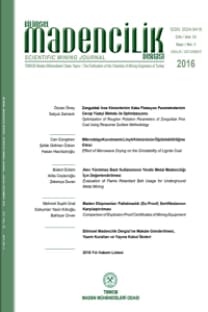FARKLI ORGANİK ASİTLERİN KAOLEN CEVHERİNDEN DEMİRİN UZAKLAŞTIRILMASINDAKİ ETKİLERİ
Kaolenlerin demir içeriğini istenilen sınır değerlere azaltmak için çeşitli fiziksel ve kimyasal yöntemler
endüstriyel olarak uygulanmaktadır. Yaygın olarak uygulanmasına rağmen fiziksel yöntemlerin
(klasik manyetik ayırma, yeni ve daha pahalı olan süper iletken manyetik ayırma) etkinliğinin düşük
olması, kimyasal demir uzaklaştırma yöntemlerinin önemini artırmaktadır. Bu çalışmada organik
asitler kullanılarak, ÇİMSA A.Ş.’den alınan kaolen numunesinde safsızlık olarak bulunan demirin
uzaklaştırılması araştırılmıştır. Farklı organik asitlerin performansı, sıcaklık, katı/sıvı oranı, liç süresi ve
reaktif derişimi gibi parametrelerin demir uzaklaştırma verimine etkisi Yates deneysel düzen tekniğine
göre yapılmış olup, elde edilen sonuçların değerlendirilmesi işlemleri için ANOVA-Yates analizi
uygulanmıştır. Belirlenen optimum şartlarda (katı/sıvı oranı: %10, oksalik asit derişimi: 40 g/L, sıcaklık:
90°C, liç süresi: 120 dk) oksalik asit liçinde Fe2O3 giderim verimi %34,45 olarak tespit edilmiştir
Anahtar Kelimeler:
Kaolen, Saflaştırma, Organik asit, Liç, Demir uzaklaştırma
Effects of Different Organic Acids in Iron Removal from Kaolin Ore
To reduce the iron content of kaolin to the desired levels, a variety of industrial physical and chemical
processes are employed in practice. Though the physical methods (classical magnetic separation,
new and more expensive super conductive magnetic separation in particular) are extensively used,
generally low efficiency of these methods has led to the search for alternative chemical methods for the
removal of iron, which have gained importance recently. In this study, the chemical removal of the iron
impurity present in kaolin supplied by ÇİMSA Inc. was investigated by using organic acids. The effect
of parameters including the type of organic acids, temperature, pulp density, leaching time and reagent
concentration on the extent of iron removal were investigated applying factorial design ANOVA-Yates
test technique for the statistical analysis of the results. Under optimum condition (10% pulp ratio, 40
g/L of oxalic acid concentration, 90°C temperature and 120 minutes of leaching (reaction) time), the
removal of Fe2O3 was obtained as 34.45% for oxalic acid leaching.
Keywords:
Kaolin, Purification, Organic acid, Leaching, Iron removal,
- ISSN: 2564-7024
- Yayın Aralığı: Yılda 4 Sayı
- Yayıncı: TMMOB Maden Mühendisleri Odası
Sayıdaki Diğer Makaleler
REFRAKTER AKOLUK Au-Ag CEVHERİNİN KARIŞTIRMALI DEĞİRMEN İLE İNCE ÖĞÜTÜLMESİ
FARKLI ORGANİK ASİTLERİN KAOLEN CEVHERİNDEN DEMİRİN UZAKLAŞTIRILMASINDAKİ ETKİLERİ
Ayşenur TUNCUK, Selçuk ÇİFTLİK, Ali Namik GÜNEŞ, İsmail HANDIRI, HASAN ÇİFTÇİ, ATA AKÇIL
AŞINDIRICI SU JETİ İLE KESMEDE ÇALIŞMA PARAMETRELERİNİN GRANİT KERF AÇISINA ETKİSİNİN ARAŞTIRILMASI
